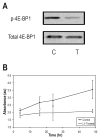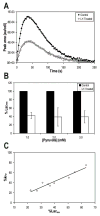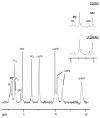Noninvasive detection of target modulation following phosphatidylinositol 3-kinase inhibition using hyperpolarized 13C magnetic resonance spectroscopy
- PMID: 20145128
- PMCID: PMC2822895
- DOI: 10.1158/0008-5472.CAN-09-2251
Noninvasive detection of target modulation following phosphatidylinositol 3-kinase inhibition using hyperpolarized 13C magnetic resonance spectroscopy
Abstract
Numerous mechanism-based anticancer drugs that target the phosphatidylinositol 3-kinase (PI3K) pathway are in clinical trials. However, it remains challenging to assess responses by traditional imaging methods. Here, we show for the first time the efficacy of hyperpolarized (13)C magnetic resonance spectroscopy (MRS) in detecting the effect of PI3K inhibition by monitoring hyperpolarized [1-(13)C]lactate levels produced from hyperpolarized [1-(13)C]pyruvate through lactate dehydrogenase (LDH) activity. In GS-2 glioblastoma cells, PI3K inhibition by LY294002 or everolimus caused hyperpolarized lactate to drop to 42 +/- 12% and to 76 +/- 5%, respectively. In MDA-MB-231 breast cancer cells, hyperpolarized lactate dropped to 71 +/- 15% after treatment with LY294002. These reductions were correlated with reductions in LDH activity to 48 +/- 4%, 63 +/- 4%, and 69 +/- 12%, respectively, and were associated with a drop in levels of LDHA mRNA and LDHA and hypoxia-inducible factor-1alpha proteins. Supporting these findings, tumor growth inhibition achieved by everolimus in murine GS-2 xenografts was associated with a drop in the hyperpolarized lactate-to-pyruvate ratio detected by in vivo MRS imaging, whereas an increase in this ratio occurred with tumor growth in control animals. Taken together, our findings illustrate the application of hyperpolarized (13)C MRS of pyruvate to monitor alterations in LDHA activity and expression caused by PI3K pathway inhibition, showing the potential of this method for noninvasive imaging of drug target modulation.
Figures






Similar articles
-
Reduced phosphocholine and hyperpolarized lactate provide magnetic resonance biomarkers of PI3K/Akt/mTOR inhibition in glioblastoma.Neuro Oncol. 2012 Mar;14(3):315-25. doi: 10.1093/neuonc/nor209. Epub 2011 Dec 12. Neuro Oncol. 2012. PMID: 22156546 Free PMC article.
-
Hyperpolarized 13C MR spectroscopic imaging can be used to monitor Everolimus treatment in vivo in an orthotopic rodent model of glioblastoma.Neuroimage. 2012 Jan 2;59(1):193-201. doi: 10.1016/j.neuroimage.2011.07.034. Epub 2011 Jul 23. Neuroimage. 2012. PMID: 21807103 Free PMC article.
-
Hyperpolarized (13)C MR imaging detects no lactate production in mutant IDH1 gliomas: Implications for diagnosis and response monitoring.Neuroimage Clin. 2016 Jun 23;12:180-9. doi: 10.1016/j.nicl.2016.06.018. eCollection 2016. Neuroimage Clin. 2016. PMID: 27437179 Free PMC article.
-
Tumor imaging using hyperpolarized 13C magnetic resonance spectroscopy.Magn Reson Med. 2011 Aug;66(2):505-19. doi: 10.1002/mrm.22999. Epub 2011 Jun 9. Magn Reson Med. 2011. PMID: 21661043 Review.
-
Phosphoinositide 3-kinase inhibition in cancer treatment.Expert Opin Investig Drugs. 2001 Jun;10(6):1085-98. doi: 10.1517/13543784.10.6.1085. Expert Opin Investig Drugs. 2001. PMID: 11772237 Review.
Cited by
-
Non-invasive metabolic imaging of brain tumours in the era of precision medicine.Nat Rev Clin Oncol. 2016 Dec;13(12):725-739. doi: 10.1038/nrclinonc.2016.108. Epub 2016 Jul 19. Nat Rev Clin Oncol. 2016. PMID: 27430748 Free PMC article. Review.
-
HDAC inhibition in glioblastoma monitored by hyperpolarized 13 C MRSI.NMR Biomed. 2019 Feb;32(2):e4044. doi: 10.1002/nbm.4044. Epub 2018 Dec 18. NMR Biomed. 2019. PMID: 30561869 Free PMC article.
-
High-field small animal magnetic resonance oncology studies.Phys Med Biol. 2014 Jan 20;59(2):R65-R127. doi: 10.1088/0031-9155/59/2/R65. Epub 2013 Dec 30. Phys Med Biol. 2014. PMID: 24374985 Free PMC article. Review.
-
Analysis of cancer metabolism by imaging hyperpolarized nuclei: prospects for translation to clinical research.Neoplasia. 2011 Feb;13(2):81-97. doi: 10.1593/neo.101102. Neoplasia. 2011. PMID: 21403835 Free PMC article.
-
Reduced Warburg effect in cancer cells undergoing autophagy: steady- state 1H-MRS and real-time hyperpolarized 13C-MRS studies.PLoS One. 2014 Mar 25;9(3):e92645. doi: 10.1371/journal.pone.0092645. eCollection 2014. PLoS One. 2014. PMID: 24667972 Free PMC article.
References
-
- Brader S, Eccles SA. Phosphoinositide 3-kinase signalling pathways in tumor progression, invasion and angiogenesis. Tumori. 2004;90:2–8. - PubMed
-
- Luo J, Manning BD, Cantley LC. Targeting the PI3K-Akt pathway in human cancer: rationale and promise. Cancer Cell. 2003;4:257–62. - PubMed
-
- Samuels Y, Wang Z, Bardelli A, et al. High frequency of mutations of the PIK3CA gene in human cancers. Science. 2004;304:554. - PubMed
-
- Hennessy BT, Smith DL, Ram PT, Lu Y, Mills GB. Exploiting the PI3K/AKT pathway for cancer drug discovery. Nat Rev Drug Discov. 2005;4:988–1004. - PubMed
Publication types
MeSH terms
Substances
Grants and funding
LinkOut - more resources
Full Text Sources
Other Literature Sources
Miscellaneous

